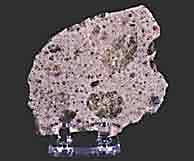HED meteorite on:
[Wikipedia]
[Google]
[Amazon]
HED meteorites are a clan (subgroup) of
/ref>

 No matter their composition all these types of meteorite are thought to have originated in the crust of the asteroid Vesta. According to this theory the differences of composition are due to their ejection at different moments in the geologic history of Vesta. Their crystallization ages have been determined to be between 4.43 and 4.55 billion years from
No matter their composition all these types of meteorite are thought to have originated in the crust of the asteroid Vesta. According to this theory the differences of composition are due to their ejection at different moments in the geologic history of Vesta. Their crystallization ages have been determined to be between 4.43 and 4.55 billion years from
Meteorite articles, including discussions of HEDs, in Planetary Science Research Discoveries
{{Meteorites Planetary science Asteroidal achondrites 4 Vesta
achondrite
An achondrite is a stony meteorite that does not contain chondrules. It consists of material similar to terrestrial basalts or plutonic rocks and has been differentiated and reprocessed to a lesser or greater degree due to melting and recrystalliz ...
meteorites. HED stands for "howardite
Howardites are achondritic stony meteorites that originate from the surface of the asteroid 4 Vesta, and as such are part of the HED meteorite clan. There are about 200 distinct members known.
Characteristics
They are a regolith breccia consisti ...
– eucrite– diogenite".
These achondrites came from a differentiated parent body and experienced extensive igneous processing not much different from the magmatic rocks found on Earth and for this reason they closely resemble terrestrial igneous rocks.All about Meteorites/ref>
Classification
HED meteorites are broadly divided into: *Howardite
Howardites are achondritic stony meteorites that originate from the surface of the asteroid 4 Vesta, and as such are part of the HED meteorite clan. There are about 200 distinct members known.
Characteristics
They are a regolith breccia consisti ...
s
* Eucrites
* Diogenites
Several subgroups of both eucrites and diogenites have been found.
The HED meteorites account for about 5% of all falls, which is about 60% of all achondrite
An achondrite is a stony meteorite that does not contain chondrules. It consists of material similar to terrestrial basalts or plutonic rocks and has been differentiated and reprocessed to a lesser or greater degree due to melting and recrystalliz ...
s.
Origin

 No matter their composition all these types of meteorite are thought to have originated in the crust of the asteroid Vesta. According to this theory the differences of composition are due to their ejection at different moments in the geologic history of Vesta. Their crystallization ages have been determined to be between 4.43 and 4.55 billion years from
No matter their composition all these types of meteorite are thought to have originated in the crust of the asteroid Vesta. According to this theory the differences of composition are due to their ejection at different moments in the geologic history of Vesta. Their crystallization ages have been determined to be between 4.43 and 4.55 billion years from radioisotope
A radionuclide (radioactive nuclide, radioisotope or radioactive isotope) is a nuclide that has excess nuclear energy, making it unstable. This excess energy can be used in one of three ways: emitted from the nucleus as gamma radiation; transferr ...
ratios. HED meteorites are differentiated meteorites, which were created by igneous processes in the crust of their parent asteroid.
It is thought that the method of transport from Vesta to Earth is as follows:
# An impact on Vesta ejected debris, creating small ( diameter or less) V-type asteroid A V-type asteroid or Vestoid is an asteroid whose spectral type is that of 4 Vesta. Approximately 6% of main-belt asteroids are vestoids, with Vesta being by far the largest of them. They are relatively bright, and rather similar to the more common ...
s. Either the asteroidal chunks were ejected as such, or were formed from smaller debris. Some of these small asteroids formed the Vesta family, while others were scattered somewhat further. This event is thought to have happened less than 1 billion years ago. There is an enormous impact crater on Vesta covering much of the southern hemisphere which is the best candidate for the site of this impact. The amount of rock that was excavated there is many times more than enough to account for all known V-type asteroids.
# Some of the more far-flung asteroid debris ended up in the 3:1 Kirkwood gap. This is an unstable region due to strong perturbations by Jupiter, and asteroids that end up here get ejected into very different orbits on a timescale of about 100 million years. Some of these bodies are perturbed into near-Earth orbits forming the small V-type near-Earth asteroids such as e.g. 3551 Verenia
3551 Verenia, provisional designation , is an Amor asteroid and a Mars crosser discovered on 12 September 1983 by R. Scott Dunbar. Although Verenia passed within 40 Gm of the Earth in the 20th century, it will never do so in the 21st. In 20 ...
, 3908 Nyx, or 4055 Magellan
4055 Magellan, provisional designation , is a bright and eccentric asteroid and near-Earth object of the Amor group, approximately 2.5 kilometers in diameter. It was discovered on 24 February 1985, by American astronomer Eleanor Helin at Palomar ...
.
# Later, smaller impacts on these near-Earth objects dislodged rock-sized meteorites, some of which later struck Earth. On the basis of cosmic ray exposure measurements, it is thought that most HED meteorites arose from several distinct impact events of this kind, and spent from about 6 million to 73 million years in space before striking the Earth.
See also
* Glossary of meteoriticsReferences
External links
Meteorite articles, including discussions of HEDs, in Planetary Science Research Discoveries
{{Meteorites Planetary science Asteroidal achondrites 4 Vesta